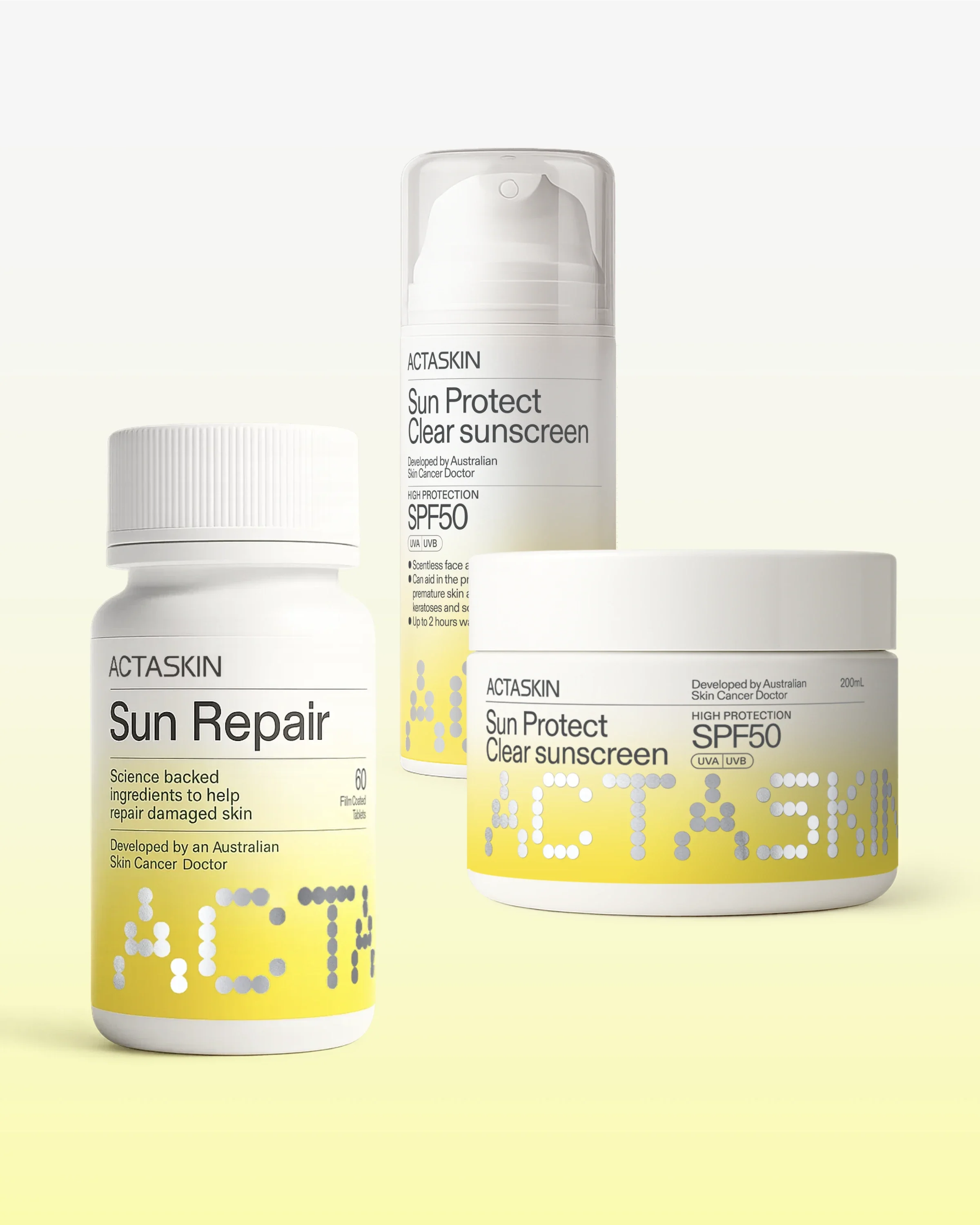The sun is both healer and hazard. It fuels our body’s vitamin D production, yet it’s the leading cause of melanoma in Australia. Striking the right balance between getting enough sun and protecting our skin isn’t just smart — it's essential for long-term health.
By Dr Austin Lang | Master of Medicine (Skin Cancer), Bachelor of Surgery, Bachelor of Medicine, Bachelor of Science, FRACGP
Chief Medical Officer, Actaskin
What does Vitamin D do?
Vitamin D plays the matchmaker role between calcium and your body. Calcium is essential for strong bones and teeth, but your body can’t absorb it properly without enough vitamin D.
Think of it like this: You can eat all the calcium-rich foods you want — like dairy, leafy greens, or supplements — but without vitamin D, much of that calcium just passes through your system unused.
Vitamin D helps by:
- Boosting calcium absorption in your gut, so more of what you eat actually gets into your bloodstream
- Helping regulate calcium levels in your blood, which is vital for bone health, muscle function, and even nerve signaling
- Telling your bones when to store or release calcium, keeping everything in balance
So in short, vitamin D helps your body unlock and use calcium properly. Without it, you can end up with weak bones, even if you’re getting enough calcium from your diet.
What’s more, vitamin D isn’t just about bones. Receptors for vitamin D are found in nearly every cell in the body — from your skin to your immune system. That means it plays a much bigger role than we once thought.
Vitamin D helps regulate how cells grow, divide, and function. Low levels have been linked to a higher risk of autoimmune conditions and greater susceptibility to infections. In short: it’s not just a bone vitamin — it’s a whole-body health essential.
Am I getting enough?
For most people, day-to-day incidental sun exposure - like walking to the bus stop or hanging out the washing is enough to maintain healthy vitamin D levels. Yet, around 1 in 5 Australians (20.6%) are vitamin D deficient - a figure that climbs to over 26% during winter. In contrast, deficiency drops to about 15.5% in summer. However this comprised 17% with a mild deficiency, 6% with a moderate deficiency and less than 1% with a severe deficiency. (Australian Bureau of Statistics [ABS], 2014)
There are clear disparities too:
- Almost half of Victorians and Canberrans are deficient in winter
- People in major cities have higher rates of deficiency (27%) compared to those in regional and remote areas
-
Older adults and people with darker skin are more likely to be deficient due to lower natural production
Importantly,
using sunscreen and sun protection does not put you at risk of vitamin D deficiency.
Fair-skinned people, in particular, get more than enough sun exposure through everyday activities, even with sunscreen on. You can be sun safe and make enough vitamin D — by avoiding high-UV periods and using sunscreen and protective clothing consistently.
What about sunscreen? Doesn’t it block vitamin D?
Here’s the truth: sunscreen does reduce UV-B, the wavelength responsible for vitamin D production. But in real life, people don’t apply sunscreen perfectly.
To completely block vitamin D synthesis, sunscreen would need to be applied thickly, to every single inch of exposed skin — and let’s be honest, no one’s doing that. Have you ever put sunscreen on your eyelids?
Studies confirm this: people who wear sunscreen don’t have lower vitamin D levels than those who don’t. That myth is well and truly debunked. (Olsen, C. M., et al. (2019). The effect of sunscreen on vitamin D: a review. British Journal of Dermatology, 181(5), 907–915. https://doi.org/10.1111/bjd.17980)
So how do I get my daily dose?
Very few foods naturally contain vitamin D. Some examples are oily fish like salmon, sardines, and tuna top the list, along with beef liver, egg yolks, and cod liver oil. But even then, you'd need to eat large amounts regularly to meet your daily needs/ That’s why, for most people, incidental sun exposure is the primary source of vitamin D.
However, people with darker skin tones may produce up to 99% less vitamin D than those with lighter skin, under the same sun exposure, due to melanin’s UV-blocking properties. And in some regions or seasons, the sun’s UV-B rays are too weak for adequate synthesis.
More than 80% of Australians have dietary intakes below the recommended vitamin D levels, with food alone contributing only around 1.8–3.2 µg/day — well short of the 5–15 µg/day recommended intake (Source: National Nutrition Survey, 2023).
In those cases, supplementation is often the safest and most effective solution without the risks of sun damage.
My vitamin D is still low — do I need more sun?
Not necessarily. Vitamin D production declines with age, even with regular sun exposure. For many older adults, increasing sun exposure won’t make much difference.
Between 15% and 52% of older Australians are vitamin D deficient, with rates highest among those in residential aged care. (Australian Institute of Health and Welfare, 2024).
Instead, vitamin D supplements are recommended, especially if blood tests confirm low levels.
Bottom line:
You don’t have to choose between vitamin D and protecting your skin. You can, and should have both.
Smart, incidental sun exposure combined with daily sun protection keeps your skin safe and your body supported. And when in doubt, a supplement can top up what nature and diet might miss - no extra UV required.
Dr Austin Lang is a skin cancer doctor renowned for his expertise in diagnosis and management, with a strong focus on prevention and patient-centered care. He leads Actaskin’s clinical strategy and product development.



